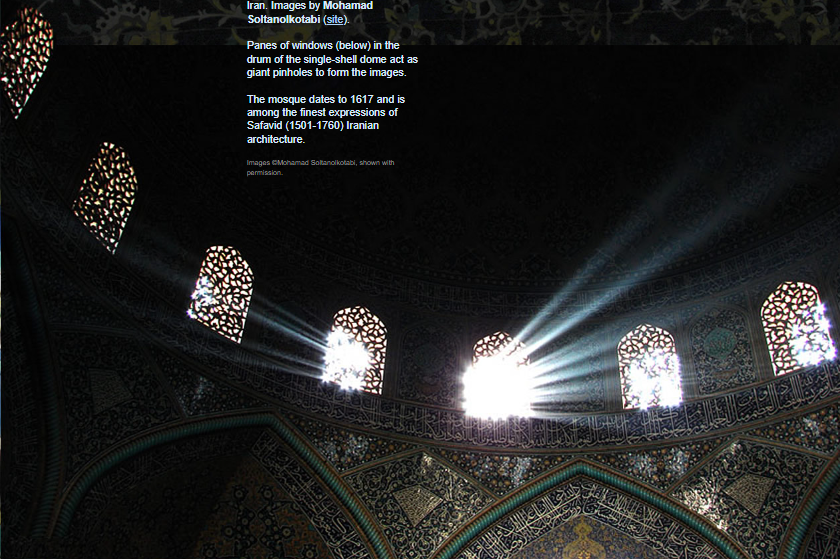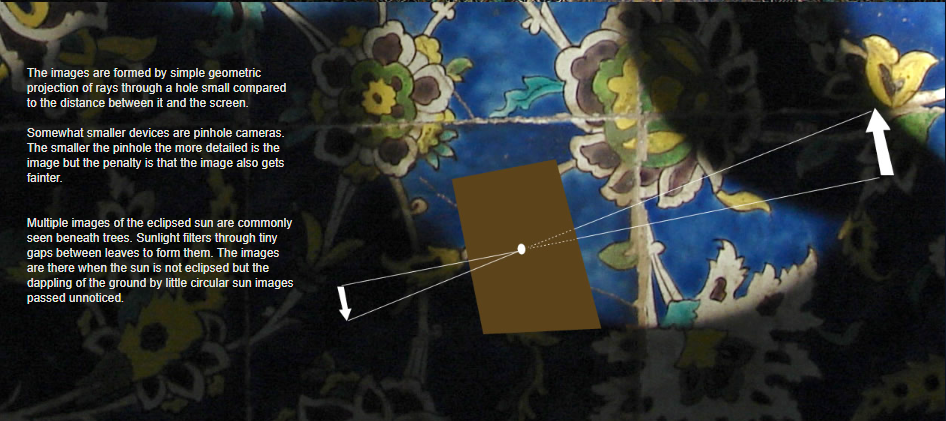OPOD - Many suns
OPOD - Many Suns: A Fascinating Display of Atmospheric Optics
Have you ever witnessed the enchanting sight of multiple images of the sun appearing beneath a tree? Perhaps you were captivated by the intricate patterns projected onto exquisitely decorated tiles inside a mosque. These mesmerizing phenomena are known as multiple or "eclipsed" suns, and they are a fascinating example of atmospheric optics. In this article, we will explore the science behind these captivating displays and uncover the secrets of their formation.
The Pinhole Effect: Unveiling the Beauty of Multiple Suns
The images of multiple suns are formed through a simple geometric projection of rays passing through a small hole. In the case of the Sheikh Lutfalla Mosque in Esfahan, Iran, the panes of windows act as giant pinholes, creating an awe-inspiring display of eclipsed suns on the beautifully adorned tiles inside. This architectural masterpiece, dating back to 1617, showcases the brilliance of Safavid Iranian architecture and provides a stunning canvas for this natural spectacle.
Pinhole Cameras: From Faintness to Detail
The concept behind multiple suns can also be observed on a smaller scale through pinhole cameras. These devices use a tiny aperture to project an image onto a screen or surface. The smaller the pinhole, the more detailed the image becomes, but there is a trade-off—the image grows fainter. This delicate balance between detail and brightness adds to the allure and complexity of multiple suns.
Nature's Canopy: A Natural Pinhole Camera
While the Sheikh Lutfalla Mosque showcases the artistic beauty of multiple suns, nature also offers its own version of this phenomenon. When sunlight filters through tiny gaps between leaves on a tree, it creates multiple images of the sun on the ground beneath. These captivating circular sun images can be observed not only during an eclipse but also on regular sunny days, often unnoticed as they dappling the ground with their mesmerizing patterns.
Unveiling the Hidden Wonders of Atmospheric Optics
Atmospheric optics encompasses a wide range of phenomena that occur due to the interaction of light with various elements in the atmosphere. Multiple suns are just one example of the mesmerizing displays that can be observed when light bends, scatters, and interacts with different mediums. By studying these optical phenomena, scientists gain insights into the behavior of light and unravel the mysteries of our atmosphere.
The Intricacies of Geometric Projection
The formation of multiple suns relies on the principle of geometric projection, where rays of light pass through a small aperture and create a projected image. This concept has been utilized in various fields, from ancient architectural designs to modern photography. Understanding the intricacies of geometric projection allows us to appreciate the beauty and complexity of multiple suns and other optical wonders.
Exploring Beyond the Surface: Layers of Atmospheric Optics
Multiple suns serve as a gateway to a vast world of atmospheric optics. Delving deeper into this realm reveals a multitude of captivating phenomena, including rainbows, halos, and mirages. Each phenomenon has its own unique set of conditions and characteristics, providing endless opportunities for scientific exploration and artistic inspiration.
A Glimpse into the Past: The Historical Significance of Multiple Suns
The Sheikh Lutfalla Mosque not only offers a breathtaking display of multiple suns but also holds historical significance as an architectural masterpiece from the Safavid era. By studying the incorporation of multiple suns in ancient designs, we gain insights into the cultural and artistic values of past civilizations. This fusion of science, art, and history allows us to appreciate the rich tapestry of human ingenuity throughout the ages.
The Magic of Perception: Appreciating Atmospheric Optics
The study of atmospheric optics invites us to explore the magic of perception and how our eyes interpret the world around us. By understanding the science behind these optical phenomena, we can deepen our appreciation for the wonders of nature and the incredible capabilities of our visual system. Whether it's witnessing multiple suns beneath a tree or marveling at the intricate projections in a mosque, these experiences remind us of the hidden beauty that surrounds us.
Embracing Wonder: A Journey into Atmospheric Optics
In conclusion, multiple suns offer a captivating glimpse into the world of atmospheric optics. From the architectural marvels of ancient mosques to the dappled patterns beneath a tree, these displays of multiple suns remind us of the interconnectedness between science, art, and nature. By embracing wonder and delving into the mysteries of atmospheric optics, we can embark on a journey of discovery and gain a deeper appreciation for the extraordinary beauty that exists all around us.

Eclipsed Suns - Multiple images of an eclipsed sun projected onto exquisitely decorated tiles inside Sheikh Lutfalla Mosque, Esfahan, Iran. Images by Mohamad Soltanolkotabi (site).
Panes of windows (below) in the drum of the single-shell dome act as giant pinholes to form the images.
The mosque dates to 1617 and is among the finest expressions of Safavid (1501-1760) Iranian architecture.
Images ©Mohamad Soltanolkotabi, shown with permission.


The images are formed by simple geometric projection of rays through a hole small compared to the distance between it and the screen.
Somewhat smaller devices are pinhole cameras. The smaller the pinhole the more detailed is the image but the penalty is that the image also gets fainter.
Multiple images of the eclipsed sun are commonly seen beneath trees. Sunlight filters through tiny gaps between leaves to form them. The images are there when the sun is not eclipsed but the dappling of the ground by little circular sun images passed unnoticed.
Note: this article has been automatically converted from the old site and may not appear as intended. You can find the original article here.
Reference Atmospheric Optics
If you use any of the definitions, information, or data presented on Atmospheric Optics, please copy the link or reference below to properly credit us as the reference source. Thank you!
-
<a href="https://atoptics.co.uk/blog/opod-many-suns/">OPOD - Many suns</a>
-
"OPOD - Many suns". Atmospheric Optics. Accessed on November 26, 2024. https://atoptics.co.uk/blog/opod-many-suns/.
-
"OPOD - Many suns". Atmospheric Optics, https://atoptics.co.uk/blog/opod-many-suns/. Accessed 26 November, 2024
-
OPOD - Many suns. Atmospheric Optics. Retrieved from https://atoptics.co.uk/blog/opod-many-suns/.